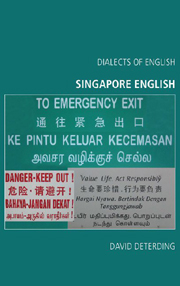3 - Morphology and Syntax
Published online by Cambridge University Press: 12 September 2012
Summary
Morphology deals with how words are constructed, including the use of affixes. There seems little difference from other varieties of English in the ways derivational suffixes such as -ity, -ness, -ology and -ism are used in Singapore. Occasionally one finds them attached to borrowed words, such as kiasuism meaning ‘the act of being kiasu’ (where kiasu is borrowed from Hokkien and means ‘fear of losing out’), and the somewhat jokey chimology meaning ‘the study of being chim’ (where chim is a borrowed word meaning ‘profound’). Extracts 1 and 2 illustrate the use of these two words in blogs.
(1) So I should give more inputs to enhance my employability. Am I too ‘kiasu’? Maybe. Kiasuism is the production of the competition, I suppose.
{Vicky, 8/6/06}(2) they discussed the topic on ‘occult’. Man! It's chimology.
{SK, 7/5/06}The creation of new words such as these indicates that derivational suffixes are productive and that Singaporeans manipulate them in the same way as other users of English.
There is somewhat more difference in the ways inflectional suffixes occur in Singapore English when compared to the usage found in traditional varieties of English such as those of Britain or America. Here, we will consider inflectional suffixes such as -ed in the past-tense form of the verb and -s in both the third-person singular present-tense form of the verb and the plural form of the noun.
- Type
- Chapter
- Information
- Singapore English , pp. 40 - 61Publisher: Edinburgh University PressPrint publication year: 2007



